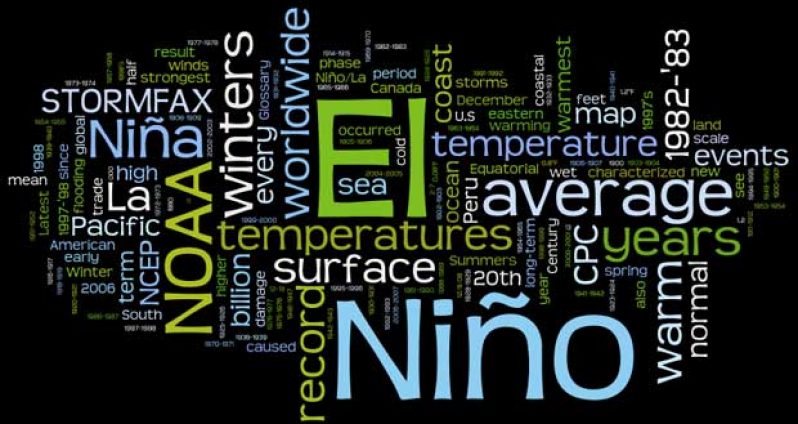–Sugar and rice sectors prepared for adverse weather conditions
GUYANA’S two major agricultural sectors, rice and sugar, are bracing for the impacts of the expected El Nino conditions during the coming months.
The Ministry of Agriculture, having consulted with its Hydro-Meteorological Office, and taking into consideration predictions from various regional and international forecasting and weather agencies, issued an El Nino Watch on Friday.
According to the Agriculture Ministry, Guyana’s rainfall for the period beginning in March and extending to the present time in May has been below the average expected in accordance with the long-term averages; and subject minister, Dr. Leslie Ramsammy told the Guyana Chronicle that steps are being taken in the sugar belt to prepare for the onset of El Nino.
He said, “We will have some kind of El Nino conditions this year, whether it is full blown or not, but I think if we manage the water situation like we did during the mini-El Nino we had last year, we would be able to deal with the impacts.
“I am concerned about the level of water in our conservancies…. (considerably lower than normal) Normally, in April we would open the conservancy to let water out, to create space for the May/June rains; but it is already early May and the rains haven’t come.”
The water level data from the four main conservancies as at last Friday indicated that:
* The East Demerara Water Conservancy (EDWC) stands at 55 Georgetown Datum (GD), over its full supply level of 57.5 GD;
* The Mahaica/Mahaicony/Abary (MMA) stands at 60.25GD over its full supply level of 64 GD;
* The Boeraserie currently stands at 59.30GD, compared to the full supply level of 61.3GD; and
* The Tapakuma stands at 56.6GD over the fully supply level of 57.5GD.
Minister Ramsammy indicated that the Agriculture Ministry is prepared to pump water where necessary. He said, “Not to say that the rains will not come, but if it comes it may come late and not as much…. Whether it is enough to fill the conservancy is another matter, so we will continue to pump water; it will mean additional costs for the ministry, as well as GuySuCo, to address this.”
An El Nino working group comprising people into agriculture, people from the private sector and people from ministries such as Public Works, Local Government etc. has been formed to confront the impending situation.
FARMERS COOPERATING
Head of the Guyana Rice Producers’ Association (RPA), Mr Dharamkumar Seeraj, said that since the advisory has been issued, rice farmers have been cooperating.
He said: “The issue of expected less-than-normal rainfall is one we are addressing. (The weather condition) is expected to be mild, which is reduced or below normal rainfall.
“The May/June rains have never failed us in the past. During periods of El Nino, we have been failing with the December/January rains in the past. But rice does well in dry weather, provided we have water for irrigation and so on in place,” Mr. Seeraj said.
According to him, the RPA is talking to farmers about conservation and efficient use of the water. “We have also advised against tampering (with) our irrigation systems. We have had discussions with our major conservancy operators in terms of the monitoring, to ensure there is no escape of water anywhere, and that they operate in the most efficient manner possible, so that we can use what is stored there already. We are prepared for the impacts of El Nino.”
Guyana has, and continues to be, a victim of climate change, but the country has taken steps to adapt to its impacts.
The Agriculture Ministry said the El Nino/Southern Oscillation (ENSO) diagnostic discussion issued on May 8 by the Climate Prediction Center (NCEP) and the International Research Institute for Climate and Society has indicated there is now more than a 65 percent chance that the Northern Hemisphere will experience El Nino conditions by the June/July/August season.
Meanwhile, La Nina, above average rainfall in an area for a particular period of time, is generally associated with drier places, and follows a period of El Nino.
Additionally, in late April, the National Oceanographic and Atmospheric Administration (NOAA) warned countries that the possibility of a severe El Nino must be heeded.
Climatologists and weather forecasters predicted an El Nino for the Americas, starting in July and intensifying towards October and December. The prediction as of this time is that it could be a serious El Nino with severe droughts in many parts of the Americas.
(By Vanessa Narine)





.jpg)








